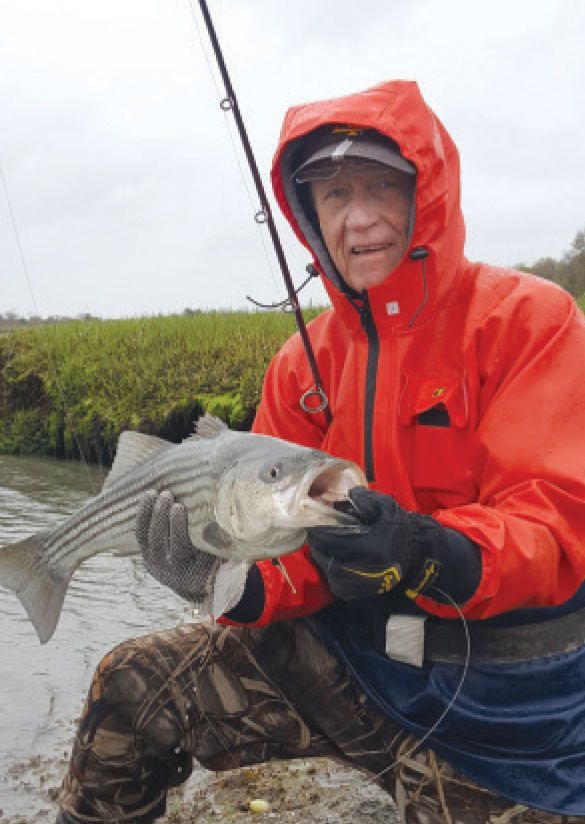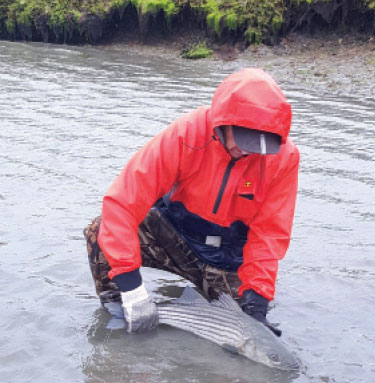
When schoolie stripers dominate early season action, it’s time to break out the light tackle and have some fun.
Picture this – It’s May, circa 1970 and a group of surf rats have moved from their April haunts in Little Neck Bay to begin prowling the north shore harbors. The target is small stripers that are common in the areas during the early spring. Hang with me, I have a point. Their surf bags contain wooden plugs, a few not-so-shiny tins, and some crudely tied bucktails, but this isn’t the main point. It’s the rods, reels, and line that set up this article. The group of anglers fishes with 11-foot rods, large heavy reels (like the Crack), and 20-pound test monofilament lines. Gee, the very thought of monofilament line send chills up my spine. Frankly, I sometimes wonder how we ever managed to catch fish regularly with such gear.
Change is inevitable, and that’s as true of surf fishing gear as it is of anything else. Enter the 1970s, then the ‘80s, and the ‘90s: each decade introducing new products that became possible because of the development of new technologies and inventive minds. However, our gang from 1970 knows nothing of this. In fact, if someone told them at the time that in the early years of the new millennia they would be fishing with braided line, smaller hi-tech reels, and graphite rods, they would have either laughed or said “what are those things?”
New Products
Yes, new products were introduced and, typically, many arrived on the market without being perfected. Graphite rods occasionally split for seemingly no reason, some of the new reels didn’t stand up to saltwater as promised, braided line knots failed and the coatings came off revealing multiple braid fibers that often became frilly and snagged on everything. In addition, there were also “mysterious line breakoffs.” But the consumer has power, and so when they balked at the products and sales dipped, manufacturers went back to the drawing board and improved these products to the point that they are reliable and efficient today.
I was mindful of the flaws that were reported about the “new” products as they came to market and so I continued to recommend the use of 11-foot S-glass rods and monofilament lines right into the 1990s. That’s all changed, and so have I. Little by little I began using and promoting the products that performed beautifully. Thanks to rod maker John Schauer I switched to an 11-foot graphite rod, and few years later he insisted I try a 9-foot graphite rod. What a revelation these graphite rods were, and soon I matched them to a Van Staal 250 on the 11-foot rod and a VS200 to the 9-footer. Together these tackle combinations were formidable tools. The icing on the cake came when braided lines were perfected. Today’s braid performs at the highest and most reliable levels. The fibers are infused with the protective coating so it doesn’t wear away, the lines are more limber, and there is uniformity in the strength of the line from one end to the other.
New Technology
I admit I’ve set you up for my next move forward in technology reality. I also admit that I’m often slow on the uptake. What I mean is that I’ve never been one of those guys that runs to buy the “latest, new and improved,” products. Instead, I’m a kind of wait and see guy with the occasional experiment designed to explore the fringes of what is “new.”
For example, about 10 years ago, I tried a 7-foot graphite rod with a VS 150 and braided line. It was a good rod and was great with little fish, but every time I hooked a big fish the rod bent over in submission and I found myself just holding on and not fighting the fish. This tackle wasn’t ready for prime time—yet.

be released.
I had wondered a few things about the light tackle I was using during several fishing trips with Rich and Marc Lazar in their boat. I noted that they cast farther than me, and seemed to control fish with more ease. Why I didn’t ask sooner I don’t know, but one day I was being out-fished and I asked to use Rich’s rod. Very different! I bought the rod a few days later: a Shimano Teramar 7-foot medium heavy power rod with an extra fast action tip. The fast action allows one to snap lures a long way and the MH power allows an angler to manage big fish, while the quality of the product over-all was excellent.
Don’t get me wrong, I haven’t thrown out or sold my bigger surf gear. An angler can’t escape the need for bigger gear with a strong wind in one’s face, big waves, casting into strong inlet currents, or when a 3- or 4-ounce lure is needed. Sportsmen also have the responsibility to think about the health of the fish we catch. The longer we fight fish, the more waste products they produce and these chemicals accumulate in their bodies, making a successful release dubious. They may swim away, but scientific research indicates that many fish fought for a long time die within three days. I believe this to be an important responsibility that I take very seriously.
However, the winter after trying Lazar’s rod I began to think about using the Teramar, VS 150, and 20-pound test Sufix Performance braid set-up in quiet water for springtime surf caught schoolies. I decided to experiment in the spring. I needed answers to questions such as could I land these fish fast enough so as not to endanger them, could I get long enough casts with light lures, and could I fight the fish with control?
A Time and a Place
Many anglers seem to be in love with the idea of light tackle, but they may take it too far. As I pointed out above, there’s a time and a place for heavier tackle, and a time and a place for light tackle. Not wimpy gear, mind you, but lighter gear that has the “goods” to get the job done.
Now, my experiment was restricted to North Shore quiet waters, such as western Sound harbors, where I had little expectation of truly large fish: teen-sized fish perhaps, but monsters -not likely. I enjoyed those school stripers very much on light tackle, but in early May when the blues arrived on the South Shore, I hung the light tackle on the wall in favor of my 9-foot rod, VS 200, and of course 20-pound test braid.
I decided to also have faith in some other “new” products and made alterations to my terminal set up. I had seen packages of Spro 50-pound barrel swivels on the wall of tackle shops but wondered whether they would hold up to saltwater fish. However, I decided to try them. These swivels are so small they easily slide through tip-tops and can barely be seen when your lure dangles from the tip of your rod. I also dropped down in leader size, too: from 30- to 20-pound test. Finally, instead of the 125-pound test Tactical Anglers paperclip style snap, I used a 75-pound size on the end of my leader.
Presentation
I realized quite quickly that gear changes also required small changes in my presentations. For one thing, the diameter of the VS 150 is almost half the size of the VS 200, and therefore would affect both casting distance and retrieve speed. The wider the reel’s spool, the longer the cast and conversely narrower spools produce shorter casts. The “right” rod (as described above) helps the angler make longer casts, but cannot equal those produced with VS200 or 250 models. Narrow spools also affect the rate of the retrieve because one turn of the handle picks up less line than one turn with a VS 200. One might think that this would have occurred to me immediately, but it took about 10 minutes on the first trip. I couldn’t understand why I kept hitting bottom with the same size bucktail I always used with my VS 200 at this location: then the dawn broke. If an angler isn’t used to the retrieve difference using a small reel, it may take a few casts to find the “sweet spot” of retrieve speed.
The spring isn’t continuously tranquil, and a cross wind over calm water may still present enough problems to the light tackle angler that the better choice is larger gear. Cross winds are difficult enough to manage with 9- and 11-foot gear, let alone a 7-foot outfit. Also, there are times when repositioning so that the wind is coming from behind you is impossible, and under these weather circumstances the light gear can be frustrating to use. My advice is check the marine weather report carefully before you gear up and match this to the quiet water spot you’ll be fishing. A word of caution, don’t use the New York City forecast or the Islip forecast because winds reported at these locations will be less than those over water. As a general rule, I triple the predicted wind speed for the city or inland L.I. spots.
Also, keep in mind that there is a curious phenomenon that sometimes occurs on Long Island. That is, predicted speeds and directions don’t always match reality. For example, a prediction of a southeast wind direction on the south shore often turns out to be northeast on the north shore. Similarly, a southwest wind on the south shore may turn out to be northwest on the north shore. These are some of the reasons why I make an effort to hear the marine forecast. Perhaps you’d like to try quiet water light tackle spring schoolie fishing, but make sure your gear, although light in weight, has the guts to get the job done.




